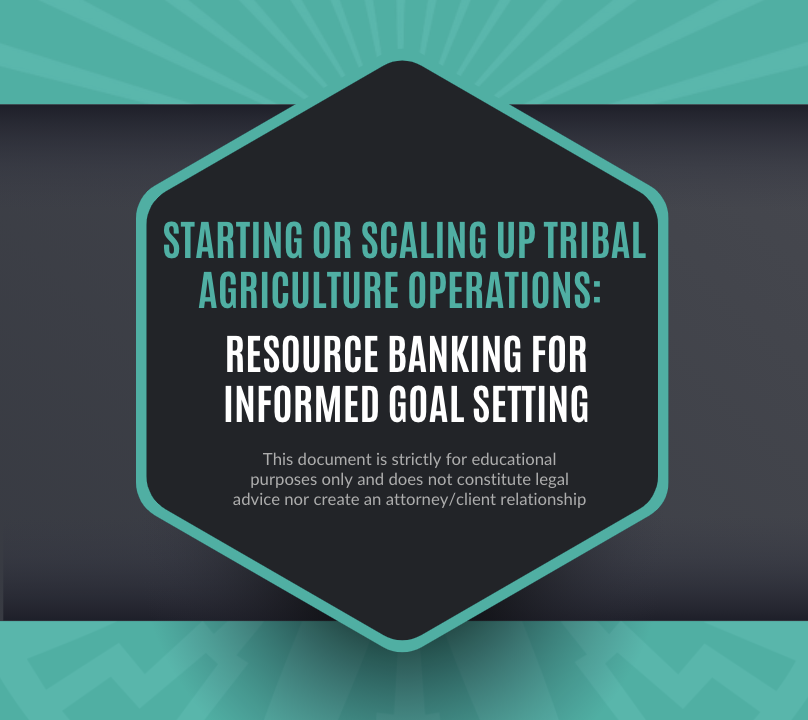This document is strictly for educational purposes only and does not constitute legal advice nor create an attorney/client relationship.
This worksheet is intended to assist in the development of an inventory of resources available to individual producers. In order to set practical and realistic goals for Tribal Agriculture Enterprises, information about existing operations assets, and available guidance materials should be compiled and reviewed for more complete decision making and goal setting.
By reviewing resources, owners and operators will be able to analyze the information and then determine/prioritize the opportunities and direction of their tribal agribusiness such as:
- Available Resources for Maximum Utility
- Revenue Generation
- Vertical Integration/Self-Sourcing
- Regulatory Implications
Land
Example
400 acres in fee, adjacent to 600 acres in trust, 130 currently arable, used for hay meadow, two ponds on property with disabled pump on one pond. 45 minutes/40 miles from tribal campus, possible trespass issues from hunters.
List how many acres/parcels? In trust, fee, restricted status? How many leased parcels acres? Any appropriate land currently available for acquisition by purchase, by lease?; Then per parcel of particular interest: How many arable acres? Location of land/proximity to markets and infrastructure? Currently in production/operation? What is produced or operated on the parcel? Best use? Any potential issues with the land.
Facilities/Buildings
Example
One 10,000 sq ft metal barn buildings, former dairy barn, used for hay storage, connected to electricity, dilapidated office/storage space, 6 individual stalls and one large stall, two overhead garage doors on south and west side, large double sliding barn doors on North and East side, textured concrete floor, 50 minutes/ 44 miles from tribal campus and market outlets like sale barns, ports, farmers markets, post office, 8 minutes from nearest town, connected to cattle working pens, on ranch site.
List Barns, Office Space, Warehouses, Storage, residential buildings, retail space, fairgrounds, event spaces, etc… Square footage? Utilities? Proximity to population centers/tribal citizens/ customers/buyers/consumers/wholesales/distributors/food hubs? Condition of each building?
Equipment
Example
One Peterbilt tractor trailer, 1989 model, in Fleet Surplus yard. One John Deere 450M Round Baler, 2019 model, Natural Resources program inventory.
List inventory of equipment for possible Dept. of Ag use like vehicles, trailers, tractors, ag machinery, chutes, implements, sprayers, processing/packing equipment, computers, tablets, printers, drones, refrigeration units, backhoes, dozers, feed mixers, generators, pumps, welders, boats, etc… List Item then indicate, if known, brand, model, year, condition and location (program and/or physical).
Also, if shared/loaned/borrowed equipment, who owns?
Or if tribe or other group offers access to equipment, (with or without operators to perform the work) what equipment from what group? i.e., (10 hours of Dozer work from Tribal conservation commission)
Expertise
List any people accessible with information regarding agriculture, food/nutrition, program operations, tribal policy, etc… These could be current or former employees, current or former elected officials, elders with historical knowledge, tribal scholars, educators/researchers, extension agents, BIA personnel, adjacent land holders, family and friends. List name, position, topic of expertise, and contact information.
Water
Consider any water rights that come with land, or tribal provisions possibly via treaty that authorize water use (frequently in tribal treaty rights as much water as needed for agriculture production activities, varies per tribe); water available (ocean, rivers, streams, lakes, ponds, ground water, municipal water sources, seasonal water sources, water collection locations), access to water (land on or near rivers/streams, utility infrastructure, irrigation, wells, transported water); annual precipitation averages; water management districts/entities (municipal, tribal, IHS, commissions, boards, county, state, BLM/Bureau of Reclamation and what jurisdictional issues need to be considered).
Support
Partners- (investors, chambers of commerce, economic development incubators, private funders, partner governments, non-profits/non-government operations); BIA staff; family; neighbors; elected representatives; community groups; industry groups; non-profits/public organizations
Access to credit: banks, CDFIs, government-backed agriculture lending, like FSA loans, grants, etc…
Personnel/Labor
List current staff, potential labor pool, possible created positions, Employment and training programs, Summer youth workers, internships, possible shared labor or labor swap with other operations
Enterprises/Organizations
List current agriculture production or processing (like cattle, crops, value added operations like processing, small scale in home commercial activity, etc..), conservation activities, rangeland management, individual tribal citizen operations, individual subsistence or hobby agriculture like family gardens, wild harvest, agriculture product trade, seed saving, etc…
Guidance Information and Materials:
-
Existing Agriculture Resource Management Plan and review of how managed operation lands comply
-
Existing Integrated Resource Management Plan and review of how managed operation lands comply
-
Community and industry feedback, comments, ideas, reflections
-
Extension staff feedback, comments, ideas, reflections
-
Former business plans and financials
-
Cultural/historical knowledge & practices (harvest practices, take ratios, seed saving methods, conditions of sale/trade
Possible Opportunities:
-
Self-Governance programmatic activity benefiting individuals: List currently available options like fencing, controlled burns, hazardous fuels, irrigation, invasive species management
-
Available Tribal government or college allocations: seed distribution programs, access to youth/summer labor, Tribal extension
-
Federal funds (USDA) – EQIP, LAMP, Rural Development, RCDBG funds, etc…
-
Enterprise revenue: Money currently being earned/ collected / account receivable / Individuals Indian Money (IIM) accounts, per caps
-
Private Grant Funding (NAAF, FNDI, Non-profit funders, etc)
-
Employment and Training programs: 477 programs, Federally funded E &T Programs, Nutrition E & T programs like SNAP/FDPIR, summer youth worker program (Either to source labor or further develop own skillset)
-
Loans/Credit opportunities:
Possible Partners:
-
Tribal Cooperatives/NGOs (IAC, FNDI, IFAI, food hubs, cooperatives, local groups, local tribal governments)
-
Other Tribal Operations: List nearby or similarly situated
-
Nearby non-tribal operators
-
Educational Institutions like Tribal Colleges, Land Grant Units, and Career Techs
External Guidance Materials:
- Webinars
- Scaling Up Videos
- Model Tribal Food and Agriculture Code
- Intertribal Agriculture Council
- Technical Assistance Personnel Network
- Conservation Planning Tool Kit
- American Indian Foods Export Program
- Native Food Connection
- Made/Produced by American Indians Trademark
- First Nations Development Institute Food Sovereignty Assessment

